For Each
This Action iterates through a collection of items and executes one or more Actions in the loop.
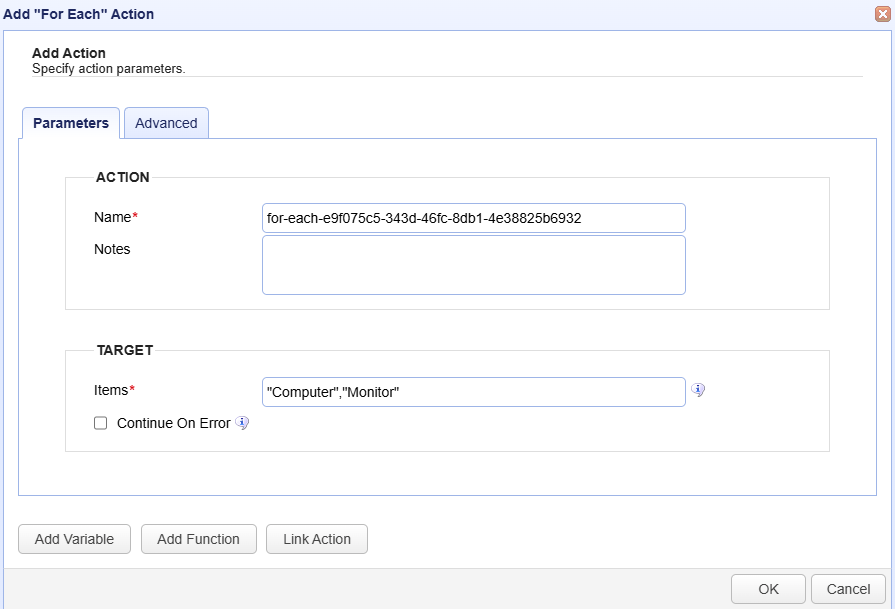
Parameters tab
ACTION
Name — Identifies the name of the Action. The system-generated default name, depicted in the image above, can be changed to a different name to suit your preferences. The Name must be unique within the current Trigger workflow.
Notes — Describes the Action.
The values in the Name and Notes fields are displayed in a tooltip when you mouse over an Action node.
TARGET
Items — Identifies a list of items. The Items field can be configured using:
Hard-coded values.
"Green","Purple","Red"
A Global variable that is defined in [Domain] >
AUTOMATION > Triggers > Settings.
Variable(name) - MyString,Value- Green,Purple,Red
To access the variable, theItemsfield is specified as follows:%GetGlobalVariable("MyString")%
The results of an Action that executes before the For Each Action. The results are passed to the For Each Action by using the GetActionResult function in the For Each
Itemsfield - for example, %GetActionResult("PriorActionName"). To see an example of this, click this link: Example - Using a For Each Action to access the Trading Partner Directory Listing results.
Actions that execute within the For Each loop use the following syntax to reference the item
:%GetActionResult("ForEachActionName")%, where the For Each ActionNameor For Each ActionIDis used as the GetActionResult's input parameter. Supporting theNameas an input parameter for the GetActionResult function was introduced as an enhancement in a more recent release of MFT Server. Using the Name as the input parameter is often more intuitive than using the system-assigned Action ID.
Continue on Error — Determines what is done if an error occurs in the loop.
If selected, and an Action fails within the loop:
The loop will continue to iterate until the end.
Any failed Action in the loop has a status of
failedin the Trigger History.The For Each Action has a status of
completedin the Trigger History.The Trigger's status is
completed(unless a failure occurs in another Action that is not part of the For Each).Any For Each > End Action configured will execute.
If not selected, and an Action fails within the loop:
The loop stops iterating when the error occurs.
Any failed Action in the loop has a status of
failedin the Trigger History.The For Each Action has a status of
completedin the Trigger history.The Trigger's status is
failed.Any For Each > End Action configured will not execute.
Outputs
Cycle — This identifies the one or more Actions that are part of the loop.
End — This identifies the one or more Actions (if configured) that execute after the loop completes.
Example: This example describes the workflow shown below.

The For Each fields are shown in the image below. The Items field is hard-coded.
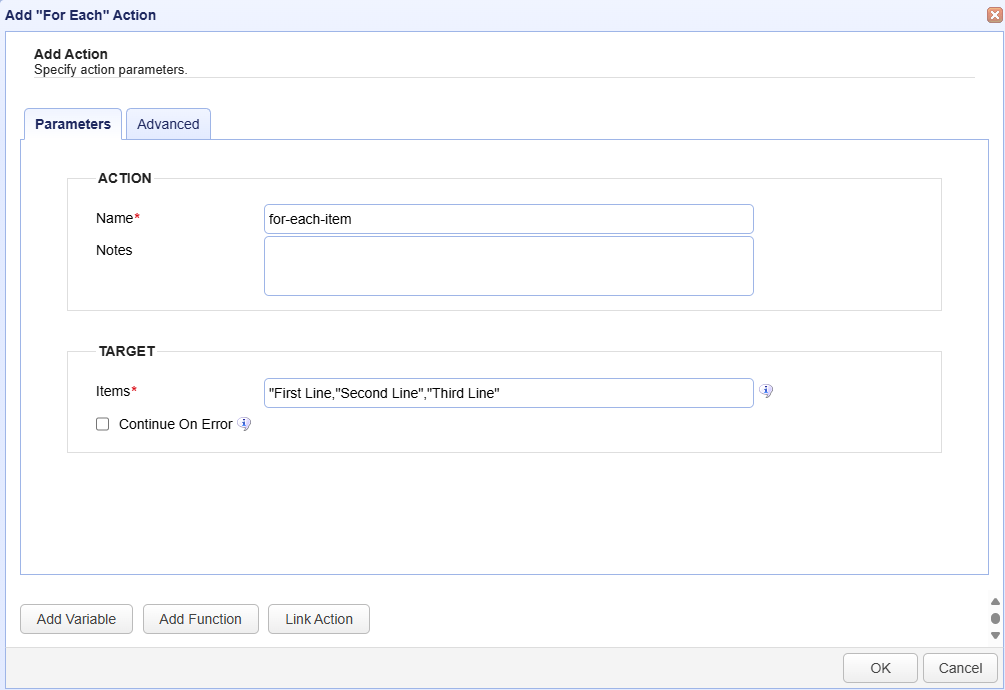
The For Each Action is named for-each-item.
The
Itemsfield is set to the hard-coded value of "First Line","Second Line","Third Line".
The For Each
Cycleoutput is configured to execute an Append File Action. This Action writes text to a file.
The Append File Action fields are shown in the image below.
The
Filefield is set to C:\Test\ForEachTest.txt. This identifies the name of the file where the text is written.
The
Messagefield is set to%GetActionResult("for-each-item")%. The GetActionResult function retrieves one For Each item at a time with each iteration of the loop. The function's input parameter is the For Each'sName. The For Each'sIDcan also be used as the input parameter.
TheIDfor any Action is obtained by right-clicking on the desired Action, then selectingCopy ID to clipboard.
When the workflow is triggered, the For Each loops three times - once for each item in the Items field. The end result is each item in the For Each Items field is written to the text file - one at a time, with each iteration of the loop.
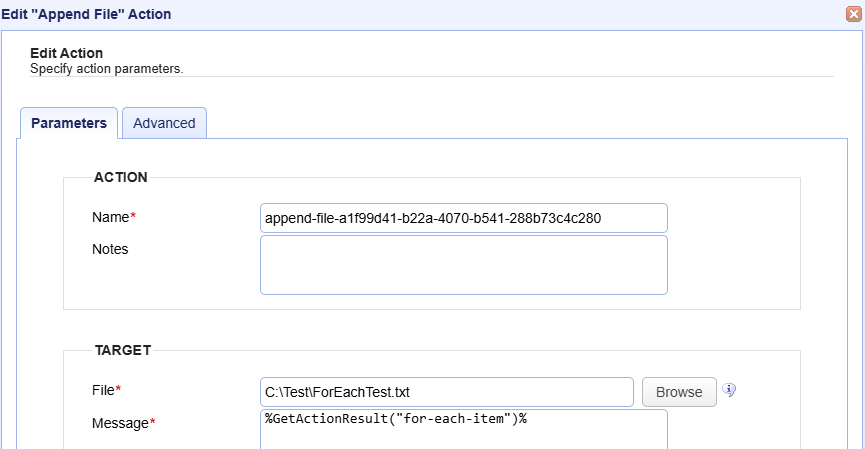
Below is the history of the Trigger after it runs. Observe the Append File Action ran three times.
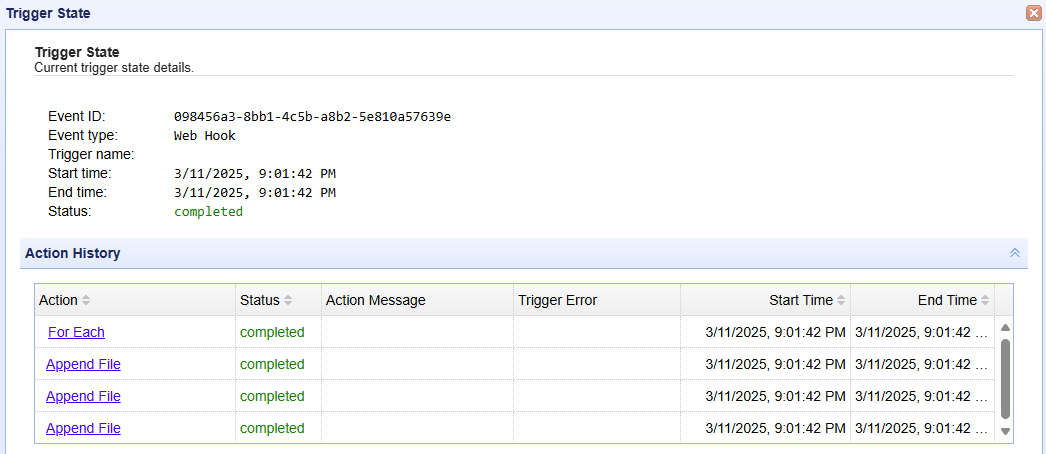
The image below displays the ForEachTest.txt file after the Trigger completes.
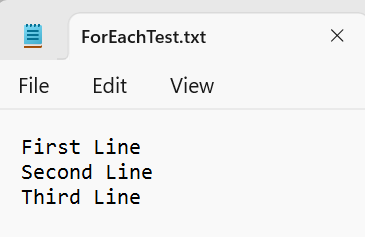
Let's modify the example a bit, keeping the ForEach Action the same, but deleting the Append File Action, and replacing it with a System Out Action. The Message field in System Out is set to %GetActionResult("for-each-item")%.
In the Trigger History, you will see something like this when the Trigger runs:
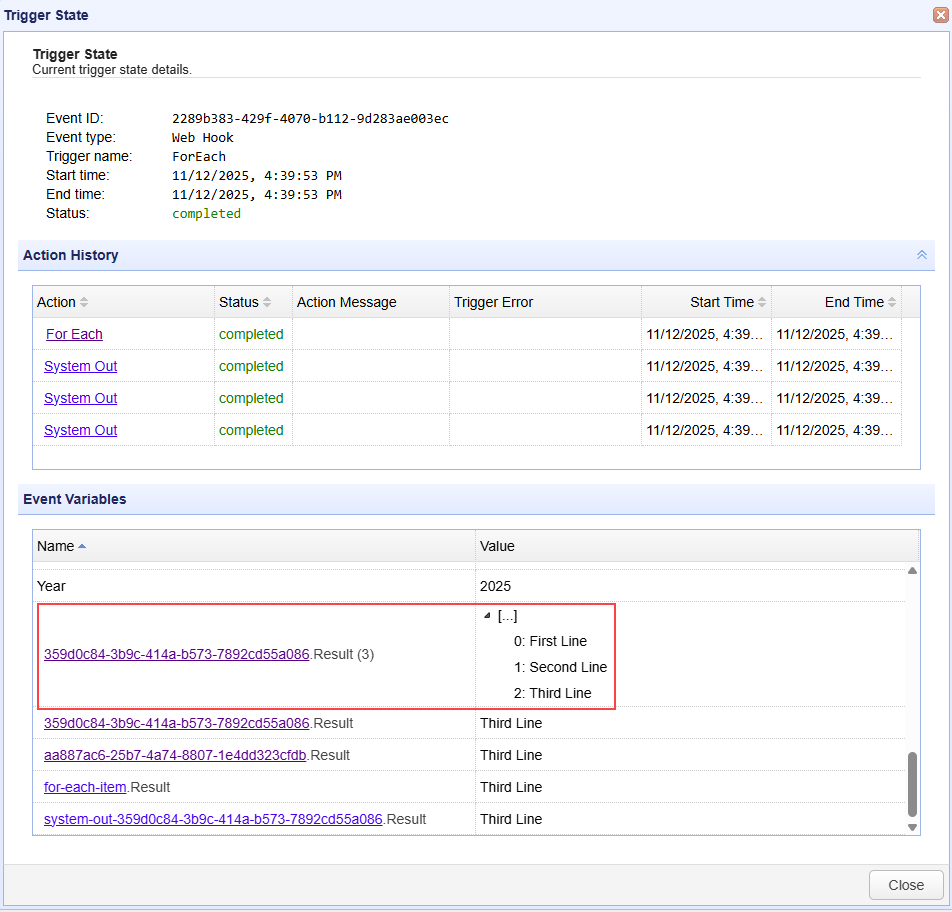
Message field to return the For Each result - e.g., %GetActionResult("for-each-item")%. The results are outlined in red in the above image.
Advanced tab
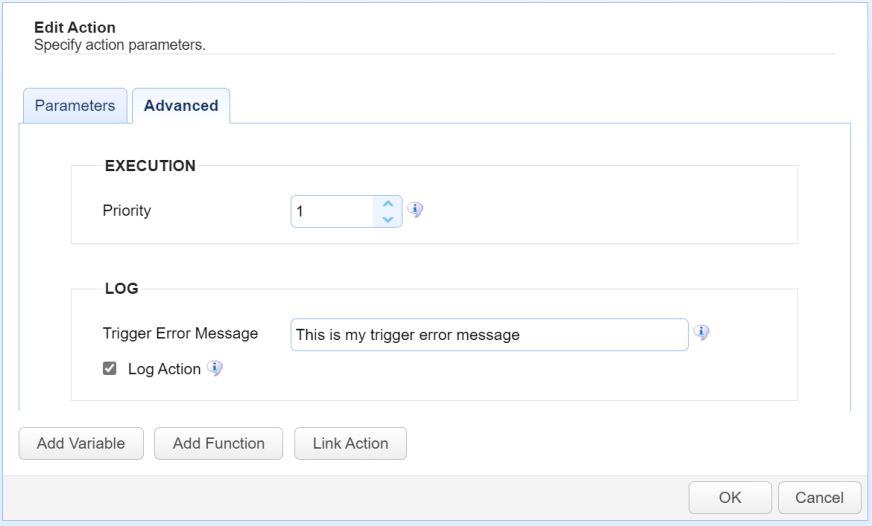
EXECUTION
Priority — Identifies the Action’s priority. An Action can be interrupted by an Action with a higher priority. The highest priority is 1. The maximum priority value is 1000. Priority comes into play when certain scenarios occur, like when Triggers or transfers are exceeded (see Settings for more information).
LOG
Trigger Error Message — Used when a Trigger Action fails. The two uses are described below.
The Trigger Error Message is displayed in the
Trigger Errorcolumn of the Action history (Triggers > History > View).
If you create an error-handling Trigger, the Trigger Error Message is passed to the error-handling Trigger.
An error-handling Trigger is a distinct Trigger that uses the
Trigger ErrorEvent type, as selected in theTrigger > Parametersdialog.If a Trigger Error event occurs, the Trigger Error Trigger runs.
The Trigger Error Message is accessible in the Trigger Error Trigger as a variable named TriggerErrorMessage.
The image below depicts the
Trigger Error Messagedisplayed in the history of a failed Trigger Action.

The image below depicts selecting the
Trigger ErrorEvent type used to handle Trigger errors.
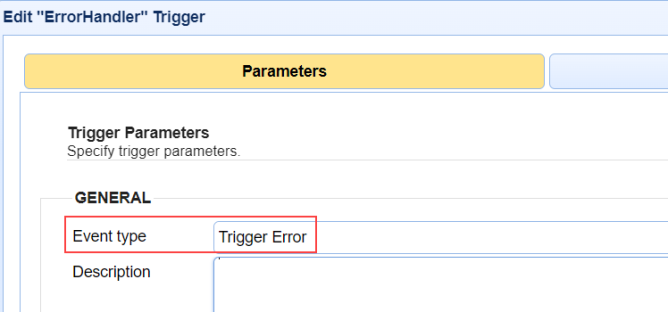
The image below depicts a Trigger Action (part of the Trigger Error Trigger workflow) accessing a
Trigger Error Message. This is accomplished using the TriggerErrorMessage variable. To reference built-in variables, enclose the variable name in percent signs (%).

As a practical use case example, you can reference the
Trigger Error Messagein the body of an Email Action that is part of the Trigger Error workflow. The email alerts interested parties that a Trigger Action failed.Log Action — When selected, Trigger Action records are added to the
Domain > AUDIT > Loggingmodule. The state of the Action is included, such as action started, action completed, and action failed. When unselected, Action records are not added to the Logging module. However, the Trigger itself is still logged.
Buttons
Add Variable— Displays a list of built-in event variables. Each Trigger has several event variables you can use in one or more of the Trigger Action fields. When a variable is selected from the list, it is added to the Action field that is currently active. Built-in event variables are enclosed using the percent sign (e.g., %DomainName%).
In addition to using built-in variables, you can also specify a user-defined global variable, created in
AUTOMATION > Triggers > Settings. To reference a global variable ( Defining global variables), use the %GetGlobalVariable% function.
%GetGlobalVariable("DirName")% retrieves the global variable named DirName. When using global variables, specify the variable name enclosed in quotes, as depicted in this example.
Add Function— Displays a list of built-in functions. Functions are useful for formatting or parsing a Trigger event variable. When a function is selected from the list, it is added to the Action field that is currently active. For more details about functions and their usage, see Function types.
Link Action— Displays a list of Actions. When an Action is selected, the Action ID is returned.
An Action ID (a string of alphanumeric characters) is an input parameter used in the
GetActionResultfunction. This function returns the results of a previously executed Action in the current Trigger workflow. This means that Action results can be passed to a linked (following) Action.
TheGetActionResultfunction also supports using the ActionNameas an input parameter. This is an enhancement added in a more current version of MFT Server.Using Link Action
Select a field in the Trigger Action that you want to populate using the results of a previous Action.
Click Add Function. A list of functions displays.
Select GetActionResult(actionId). The field displays %GetActionResult(actionId)%.
Highlight the word
actionIdin the field.
Click Link Action. A list of Actions displays.
Select an Action. The actionId text is replaced with the Action ID.
The GetActionResult function looks similar to this: %GetActionResult("bee7cd8b-8021-4e19-8f76-1ae382e60c9d")%